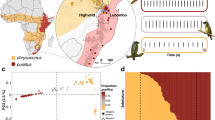Abstract
Why do highly fecund organisms apparently sacrifice offspring size for increased numbers when offspring survival generally increases with size1,2,3? The theoretical tools for understanding this evolutionary trade-off between number and size of offspring have developed over the past 25 years1,4,5,6,7,8,9,10; however, the absence of data on the relation between offspring size and fitness in highly fecund species, which would control for potentially confounding variables, has caused such models to remain largely hypothetical11,12. Here we manipulate egg size, controlling for maternal trait interactions, and determine the causal consequences of offspring size in a wild population of Atlantic salmon. The joint effect of egg size on egg number and offspring survival resulted in stabilizing phenotypic selection for an optimal size. The optimal egg size differed only marginally from the mean value observed in the population, suggesting that it had evolved mainly in response to selection on maternal rather than offspring fitness. We conclude that maximization of maternal fitness by sacrificing offspring survival may well be a general phenomenon among highly fecund organisms.
This is a preview of subscription content, access via your institution
Access options
Subscribe to this journal
Receive 51 print issues and online access
$199.00 per year
only $3.90 per issue
Buy this article
- Purchase on Springer Link
- Instant access to full article PDF
Prices may be subject to local taxes which are calculated during checkout

Similar content being viewed by others
References
Roff, D. A. The Evolution of Life Histories; Theory and Analysis (Chapman & Hall, New York, 1992).
Einum, S. & Fleming, I. A. Selection against late emergence and small offspring in Atlantic salmon (Salmo salar). Evolution 54, 628–639 ( 2000).
Einum, S. & Fleming, I. A. Maternal effects of egg size in brown trout (Salmo trutta): norms of reaction to environmental quality. Proc. R. Soc. Lond. B 266, 2095– 2100 (1999).
Smith, C. C. & Fretwell, S. D. The optimal balance between size and number of offspring. Am. Nat. 108, 499–506 (1974).
Brockelman, W. Y. Competition, the fitness of offspring, and optimal clutch size. Am. Nat. 109, 677–699 ( 1975).
Parker, G. A. & Begon, M. Optimal egg size and clutch size: effects of environment and maternal phenotype. Am. Nat. 128, 573–592 (1986).
Lloyd, D. C. Selection of offspring size at independence and other size-versus-number strategies. Am. Nat. 129, 800–817 (1987).
McGinley, M. A., Temme, D. H. & Geber, M. A. Parental investment in offspring in variable environments: theoretical and empirical considerations. Am. Nat. 130, 370–398 (1987).
Sargent, R. C., Taylor, P. D. & Gross, M. R. Parental care and the evolution of egg size in fishes. Am. Nat. 129, 32–46 (1987).
Geritz, S. A. H. Evolutionary stable seed polymorphism and small-scale spatial variation in seedling density. Am. Nat. 146, 685– 707 (1995).
Bernardo, J. The particular maternal effect of propagule size, especially egg size: patterns, models, quality of evidence and interpretations. Am. Zool. 36, 216–236 (1996).
Sinervo, B., Doughty, P., Huey, R. B. & Zamudio, K. Allometric engineering: a causal analysis of natural selection on offspring size. Science 258, 1927–1930 ( 1992).
Elgar, M. A. Evolutionary compromise between a few large and many small eggs: comparative evidence in teleost fish. Oikos 59, 283– 287 (1990).
Sinervo, B. & Licht, P. Proximate constraints on the evolution of egg size, number, and total clutch mass in lizards. Science 252, 1300–1302 ( 1991).
Fleming, I. A. Reproductive strategies of Atlantic salmon: ecology and evolution. Rev. Fish Biol. Fish. 6, 379–416 (1996).
Wade, M. J. & Kalisz, S. The causes of natural selection. Evolution 44, 1947–1955 (1990).
Sinervo, B. & Svensson, E. Mechanistic and selective causes of life history trade-offs and plasticity. Oikos 83 , 432–442 (1998).
Jonsson, N., Jonsson, B. & Fleming, I. A. Does early growth cause a phenotypically plastic response in egg production of Atlantic salmon? Funct. Ecol. 10, 89–96 (1996).
Kamler, E. Early Life History of Fish: an Energetics Approach (Chapman & Hall, London, 1992).
Einum, S. & Fleming, I. A. Genetic divergence and interactions in the wild among native, farmed and hybrid Atlantic salmon. J. Fish Biol. 50, 634–651 ( 1997).
Lande, R. & Arnold, S. J. The measurement of selection on correlated characters. Evolution 37, 1210 –1226 (1983).
Acknowledgements
We thank J. G. Backer, K. Bergersen, T. Husebø and the rest of the staff at the NINA Research Station, Ims, for assistance with the experiments. We also thank J. D. Armstrong, P. Fiske, T. Forseth, A. P. Hendry, K. Hindar, B. Jonsson and O. Ugedal for comments on the manuscript. Financial support was provided by a PhD scholarship from the Norwegian Research Council to S.E. and research funding from the Norwegian Institute for Nature Research to I.A.F.
Author information
Authors and Affiliations
Corresponding author
Rights and permissions
About this article
Cite this article
Einum, S., Fleming, I. Highly fecund mothers sacrifice offspring survival to maximize fitness . Nature 405, 565–567 (2000). https://doi.org/10.1038/35014600
Received:
Accepted:
Issue Date:
DOI: https://doi.org/10.1038/35014600
This article is cited by
-
Reproductive plasticity in response to the changing cluster size during the breeding period: a case study in a spider mite
Experimental and Applied Acarology (2023)
-
Conflict and the evolution of viviparity in vertebrates
Behavioral Ecology and Sociobiology (2022)
-
Maturation in Atlantic salmon (Salmo salar, Salmonidae): a synthesis of ecological, genetic, and molecular processes
Reviews in Fish Biology and Fisheries (2021)
-
Geographic variation in maternal investment and trade-offs between egg size and clutch size in an endemic toad of the Qinghai-Tibet Plateau
Scientific Reports (2020)
-
A spore quality–quantity tradeoff favors diverse sporulation strategies in Bacillus subtilis
The ISME Journal (2020)
Comments
By submitting a comment you agree to abide by our Terms and Community Guidelines. If you find something abusive or that does not comply with our terms or guidelines please flag it as inappropriate.



